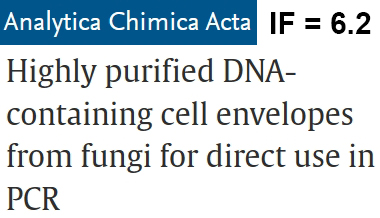Press-room / news / Science news /
New chaotropic mixtures simplify the genomic DNA preparation from fungi for PCR use
Researchers from the Laboratory of neuroreceptors and neuroregulators of IBCh RAS have improved the method of genomic DNA preparation from fungi for PCR diagnostics.
Representatives of the kingdom Fungi are extremely numerous, and in the cited literature there may be count about 1.5 million species, but the actual diversity of fungi is estimated to be between 2.2 and 3.8 million species. Fungi are ubiquitous, living in all areas, they play an important role in the destruction (catabolism) of various organic molecules. For this reason, fungi rightfully have the position of one of the most actively studied living organisms. Of particular interest are fungal species used for food, housekeeping or medical purposes, as well as pathogenic species that are dangerous for human and animal health. Due to their great practical importance, yeasts and fungi are intensively studied both by traditional mycological and genetic methods, and by modern molecular biological approach. In recent years, the polymerase chain reaction (PCR) has been widely used for the diagnostic and taxonomy of fungi. When setting up PCR, it is necessary to have a representative quantity of DNA with lower content of proteins and other impurities that can inhibit DNA polymerase. As is known, fungi and yeast have a very stable cell wall withstand to a treatment with detergents solutions, alkalis, and chaotropic salts, which makes it difficult to isolate DNA from these objects for analysis. Available on the market solutions/kits for DNA samples isolating from different cell types are have limited use in the case of fungi.
In the new paper, published in the journal Analytica Chimica Acta, authors describe a new procedure for the efficient production of semi-permeable fungal cell walls that retain inside the genomic ssDNA suitable for use as a matrix in PCR. This procedure is based on heating cells in the mixture of chaotropic agents, detergents, chelators and weak alkali, which leads to almost complete extraction of RNA and most of the proteins from the cells. At the same time, ~99% of all DNA remains inside the cell membranes. The use of the mixture containing 7 M urea, 1% sodium dodecyl sulfate (SDS), 100 mM ammonia, and 25 mM sodium citrate was the best to obtain highly purified DNA-containing cell walls from 8 fungal strains, including clinical isolates of Candida and Cryptococcus. Treated by chaotropic mixtures cell walls of fungi undergo loosening and thinning, which was confirmed by electron microscopy data. As a result scientists have developed a simple, fast, and inexpensive approach to obtaining valid for PCR samples that can be used in molecular diagnostics and taxonomy.
july 26, 2023


